How To Draw A Shear Diagram
Shear and Moment Diagrams – An Ultimate Guide
In this post nosotros're going to take a await at shear and moment diagrams in item. Determining shear and moment diagrams is an essential skill for any engineer. Unfortunately it's probably the i structural analysis skill most students struggle with almost.
This is a problem. Without agreement the shear forces and bending moments adult in a construction y'all can't complete a blueprint. Shear force and bending moment diagrams tell us nigh the underlying state of stress in the structure. So naturally they're the starting point in whatsoever blueprint process.
Another reason every graduating engineer needs to accept a solid grasp of shear forces and bending moments is because they're absolutely going to be tested in almost every graduate interview. The quickest way to tell a great CV author from a great graduate engineer is to enquire them to sketch a qualitative angle moment diagram for a given construction and load combination!
Then in this post we'll give yous a thorough introduction to shear forces, angle moments and how to draw shear and moment diagrams. We won't exist able to cover everything in this 1 post but hopefully you'll achieve the cease knowing more when you started! If you want to do a deep dive to really nail down this skill, you should take a look at my course, Mastering Shear Force and Bending Moment Diagrams [🎓 Now FREE FOR STUDENTS]. In information technology, nosotros'll cover the fundamental theory and put it into do with plenty of worked examples.
In this post we'll encompass…
- Download the DegreeTutors Guide to Shear and Moment Diagrams eBook. 📓
- Mastering Shear Force and Bending Moment Diagrams
- Your complete roadmap to mastering these essential structural assay skills.
- 1.0 What is a Bending Moment?
- 2.0 What is a Shear Strength?
- 3.0 Calculating Internal Shear Forces and Bending Moments
- 4.0 Edifice Shear and Moment Diagrams
- four.1 Finding the location of the maximum angle moment
- v.0 Drawing Shear Force and Bending Moment Diagrams – An Case
- 5.1 Video Tutorial
- 5.2 Computing the back up reactions
- v.iii Drawing the shear forcefulness diagram
- five.iv Drawing the bending moment diagram
- 6.0 Relating Loading, Shear Force and Angle Moment
- 6.1 Case 1: Uniformly distributed loading
- six.2 Example 2: Indicate force loading
- 6.3 Instance three: Point moment loading
- 7.0 Some other Example
- 7.1 Setup and shear force diagram
- vii.2 Building the bending moment diagram
- vii.3 Confirming maximum moment with calculus
- Build your own shear strength and angle moment solver
- Beam & Frame Analysis using the Direct Stiffness Method in Python
- Build a sophisticated structural assay software tool that models beams and frames using Python.
- Tutorial past:
- Dr Seán Carroll
1.0 What is a Bending Moment?
Let'south start with a basic question; what is a bending moment? To answer this we need to consider what'southward happening internally in a structure under load. Consider a just supported beam subject to a uniformly distorted load.
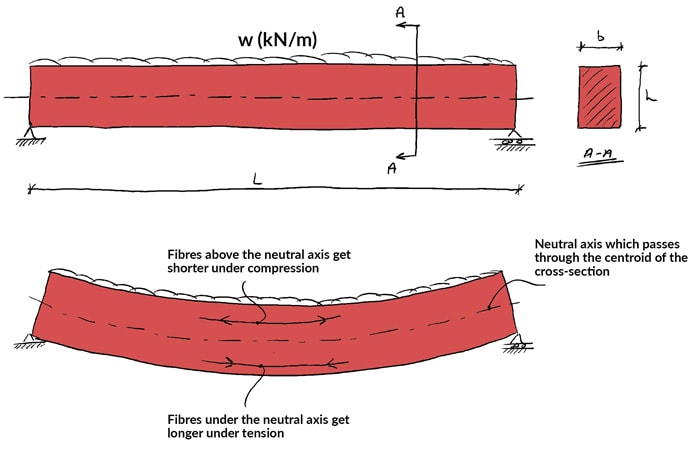
The beam volition deflect under the load. In order for the axle to deflect as shown, the fibres in the meridian of the beam must contract or get shorter. The fibres in the bottom of the beam must get longer.
We can say the meridian of the axle is in compression while the lesser is in tension (notice the direction of the arrows on the fibres in the deflected beam). At present, at some position in the depth of the beam, compression must plow into tension. In that location is a plane in the beam where this transition between tension and compression occurs. This plane is called the neutral airplane or sometimes the neutral axis.
Imagine taking a vertical cut through the beam at some distance ![]() forth the beam. We can represent the strain and stress variation throughout the depth of the beam with strain and stress distribution diagrams.
forth the beam. We can represent the strain and stress variation throughout the depth of the beam with strain and stress distribution diagrams.

Recollect, strain is just the change in length divided by the original length. In this instance nosotros're considering the longitudinal strain or strain perpendicular (normal) to the cut face.
Compression strains above the neutral axis exist considering the longitudinal fibres in the beam are getting shorter. Tensile strains occur in the lesser because the fibres are extending or getting longer.
We can presume this beam is made of a linearly rubberband material and every bit such the stresses are linearly proportional to the strains. This merely means we need to multiple the strain at some point in the beam by the Young'south modulus (modulus of elasticity) to get the corresponding stress at that point in the beam.
We know that if we multiply a stress by the area over which information technology acts, we become the resultant force on that area. The same is true for the stress acting on the cut face of the beam. The compression stresses can be represented past a compression force (stress resultant) while the tensile stresses can exist replaced by an equivalent tensile force. So for example the compression forcefulness is given by,
(1) ![Rendered by QuickLaTeX.com \begin{equation*} F_c = \underbrace{\left[\sigma_t \times \frac{1}{2} \right]}_{\text{average stress}}\underbrace{\left[ b \times\frac{h}{2}\right]}_{\text{area}} \end{equation*}](https://www.degreetutors.com/wp-content/ql-cache/quicklatex.com-a035f3b175c6917b1ffcaae12ca48aa7_l3.png)
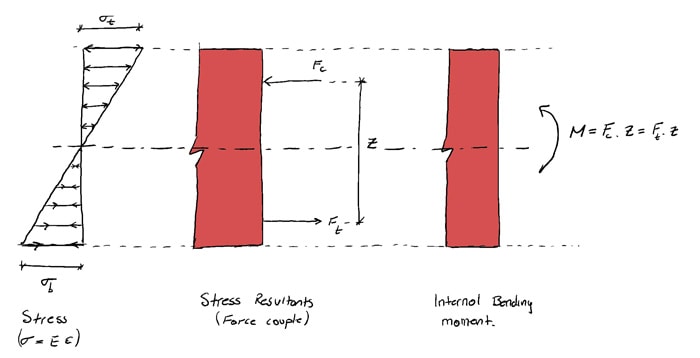
As a event of the external loading on the structure and the deflection that this induces, nosotros finish up with two forces acting on the cutting cross-section. These forces are:
- equal in magnitude (must be to maintain forcefulness equilibrium)
- parallel to each other (and perpendicular to the cutting face)
- acting in contrary directions
- separated by a distance or lever arm,

You might recognise this pair of forces as forming a couple or moment ![]() .
.
(2) ![]()
💡 The internal bending moment ![]() , is the angle moment we represent in a bending moment diagram. The bending moment diagram shows how
, is the angle moment we represent in a bending moment diagram. The bending moment diagram shows how ![]() (and therefore normal stress) varies beyond a construction.
(and therefore normal stress) varies beyond a construction.
If we know the state of longitudinal or normal stress due to bending at a given section in a construction we can work out the corresponding angle moment.
However, more ofttimes it's the case that we know the value of the bending moment at a point and utilise this to work out the maximum values of normal stress at that location.
We practice this using the Moment-Curvature equation a.k.a. the Engineer's Bending Equation…
(3) ![]()
…which relates the stress, ![]() at a distance
at a distance ![]() from the neutral centrality, to the moment,
from the neutral centrality, to the moment, ![]() . Where
. Where ![]() is the 2d moment of surface area for the cross-section.
is the 2d moment of surface area for the cross-section.
Hopefully now you tin clearly meet how bending moments arise;
- external forces induce deflections
- strains develop (which we see at a larger scale every bit structural deflections)
- where we have strains, we must have stresses (remember Young's modulus)
- these stresses, tin can be represented with their force resultants that ultimately form a couple or internal bending moment,

2.0 What is a Shear Force?
Nosotros can at present turn our attention to shear forces and first with a simple definition;
💡 A shear force is whatever forcefulness acting perpendicularly to the longitudinal centrality of the construction. We're typically interesting in internal shear forces that are the resultant of internal shear stresses developed in the structure.
Building on our discussion of bending moments, the shear force represented in the shear forcefulness diagram is too the resultant of shear stresses interim at a given point in the construction. Consider the cut confront of the beam discussed above.
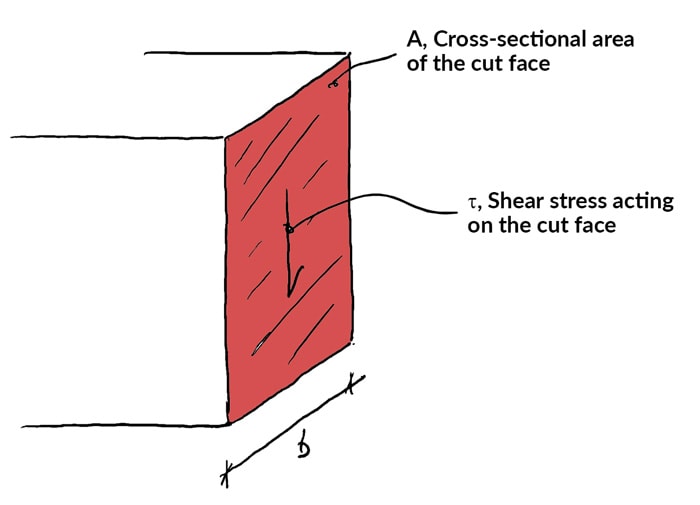
The shear stress, ![]() acting on this cutting face is evenly distributed across the width of the face and acts parallel to the cut face. The boilerplate value of the shear stress,
acting on this cutting face is evenly distributed across the width of the face and acts parallel to the cut face. The boilerplate value of the shear stress, ![]() is simply the shear force at this point in the structure
is simply the shear force at this point in the structure ![]() divided by the cross-sectional area over which information technology acts,
divided by the cross-sectional area over which information technology acts, ![]()
(4) ![]()
Yet, this is but the average value of the shear stress acting on the face. The shear stress actually varies parabolically through the depth of the section according to the following equation,
(5) ![]()
where, ![]() is the first moment of area of the area above the level at which the shear stress is being determined,
is the first moment of area of the area above the level at which the shear stress is being determined, ![]() is the second moment of area of the cantankerous-section and
is the second moment of area of the cantankerous-section and ![]() is the width of the section.
is the width of the section.
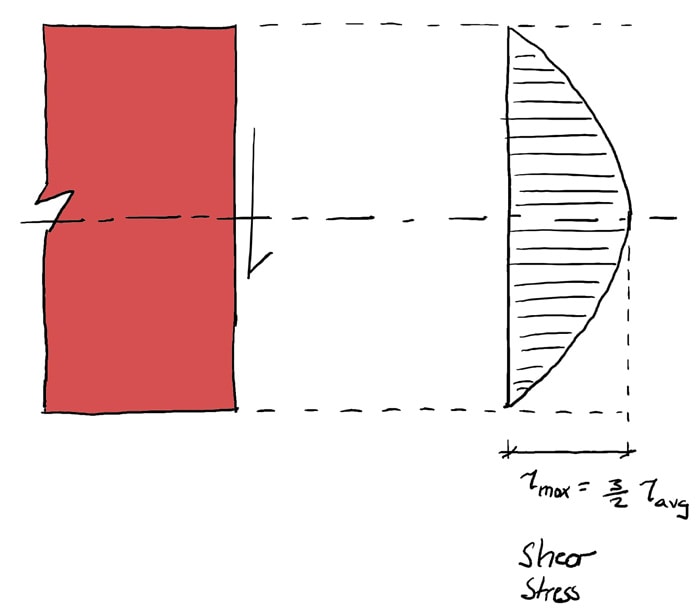
We don't want to go also far downward the rabbit hole with shear stresses. For the purposes of this tutorial, all we desire to do is establish the link between the shear strength nosotros observe in the shear forcefulness diagram and the respective shear stress within the construction. Equations (4) and (5) exercise that for us.
3.0 Computing Internal Shear Forces and Bending Moments
Up to this point we've considered the link betwixt the normal (bending) stress and associated bending moment and the shear stress and associated shear force. Based on this you should be comfortable with the thought that knowing the value of bending moment and shear strength at a bespeak are important for understanding the stresses in the structure at that indicate.
At present we're going to consider the problem of calculating shear forces and bending moments not from the point of view of internal stresses but by considering equilibrium of the construction.
In reality, this is practically how nosotros decide the shear force and bending moment at a point in the construction. Again, let's consider the just supported beam from above, subject field to a uniformly distributed load, ![]() kN/m.
kN/m.
Elementary statics tell u.s. that if the beam is in a state of static equilibrium, the left and right hand support reactions are,
(6) ![]()
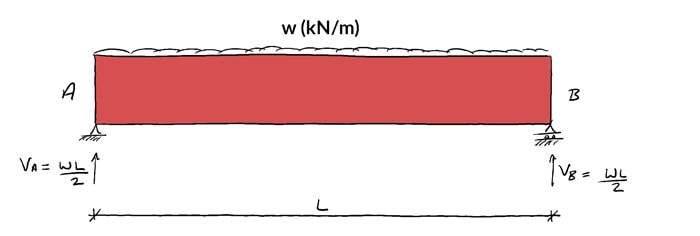
If the structure is in a country of static equilibrium (which information technology is), then whatever sub-structure or function of the structure must also be in a state of static equilibrium under the stabilising activity of the internal stress resultants.
This is a cardinal indicate! Imagine taking a cut through the structure and separating information technology into 2 sub-structures. When we cutting the structure, nosotros 'reveal' the internal stress resultants (bending moment and shear forcefulness).
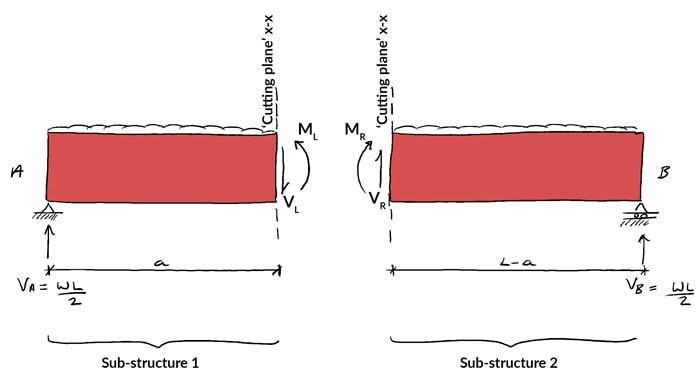
![]() and
and ![]() are the internal bending moments on either side of the imaginary cutting while
are the internal bending moments on either side of the imaginary cutting while ![]() and
and ![]() are the internal shear forces on either side of the imaginary cut.
are the internal shear forces on either side of the imaginary cut.
💡 ![]() and
and ![]() represent the influence of the left paw side of the construction (sub-structure 1) on the right hand side of the structure (sub-structure 2) and vice versa.
represent the influence of the left paw side of the construction (sub-structure 1) on the right hand side of the structure (sub-structure 2) and vice versa.
We've just said that each one of these sub-structures is stabilised by the influence of the internal bending moment and shear force revealed by the imaginary cuts.
This ways, if nosotros want to find the value of internal bending moment or shear strength at any point in a structure, we simply cut the structure at that indicate to expose the internal stress resultants (![]() and
and ![]() ). Then calculate what values they must accept to ensure the sub-structure remains in equilibrium! For example the sub-structure beneath must remain in equilibrium under the combined influence of:
). Then calculate what values they must accept to ensure the sub-structure remains in equilibrium! For example the sub-structure beneath must remain in equilibrium under the combined influence of:
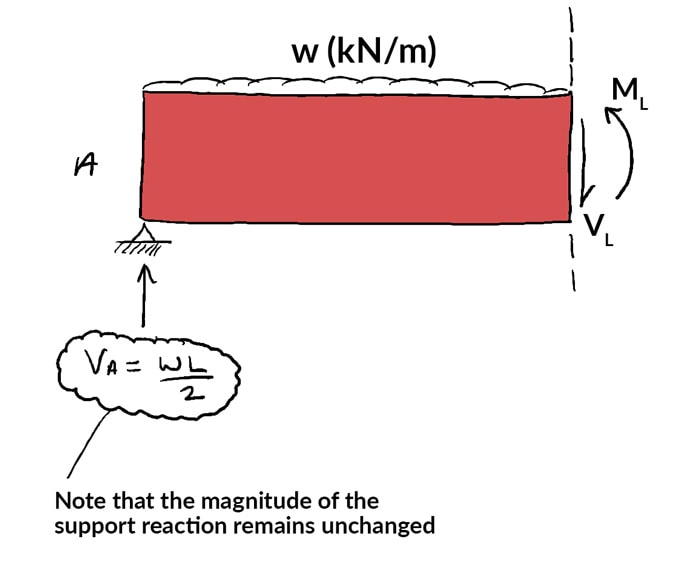
This starts to make more sense when we plug some numbers into an instance. For the axle above, allow's imagine it has a bridge ![]() one thousand, applied loading of
one thousand, applied loading of ![]() kN/m and imagine nosotros cut the beam at
kN/m and imagine nosotros cut the beam at ![]() chiliad from the left hand support.
chiliad from the left hand support.
The left hand reaction, ![]() is,
is,
(vii) ![]()
Now taking the sum of the moments most the cut and bold clockwise moments are positive,
(8) 
Then, the internal bending moment required to maintain moment equilibrium of the sub-structure is ![]() kNm. Similarly, if we take the sum of the vertical forces acting on the sub-structure, this would yield
kNm. Similarly, if we take the sum of the vertical forces acting on the sub-structure, this would yield ![]() kN.
kN.
4.0 Building Shear and Moment Diagrams
In the terminal section nosotros worked out how to evaluate the internal shear forcefulness and bending moment at a discrete location using imaginary cuts. Simply to depict a shear force and bending moment diagram, we demand to know how these values change across the construction.
What we really desire is an equation that tells us the value of the shear strength and bending moment equally a function of ![]() . Where
. Where ![]() is the position along the beam. Consider making an imaginary cut, just like to a higher place, except now we can make the cut at a distance
is the position along the beam. Consider making an imaginary cut, just like to a higher place, except now we can make the cut at a distance ![]() along the axle.
along the axle.
Now the internal shear strength and bending moment revealed by the cut are functions of ![]() , the cut position. Hither, nosotros'll determine an expression for
, the cut position. Hither, nosotros'll determine an expression for ![]() . Merely the procedure is exactly the same to determine
. Merely the procedure is exactly the same to determine ![]() .
.

Taking the sum of the moments about the cut and again assuming clockwise moments are positive,
(9) ![]()
(10) ![]()
(11) ![]()
(12) ![]()
At present we can utilise equation (12) to determine the value of the internal bending moment for any value of ![]() along the axle. Plotting the bending moment diagram is simply a matter of plotting the equation.
along the axle. Plotting the bending moment diagram is simply a matter of plotting the equation.
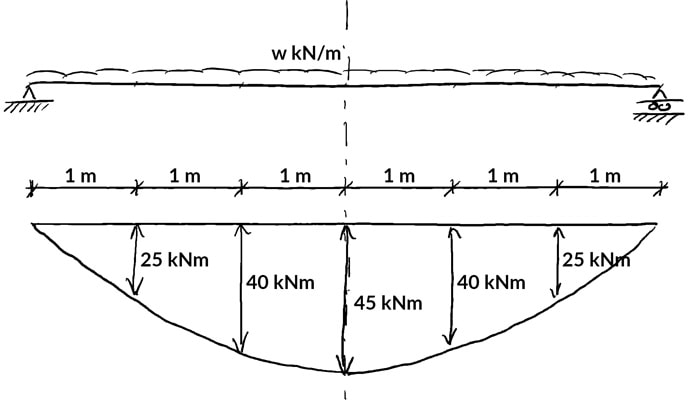
four.1 Finding the location of the maximum bending moment
In the example above, the construction and loading is symmetrical so it's pretty like shooting fish in a barrel to recognise the location of the maximum moment and so afterward to evaluate it.
However this may non ever be the example. And so it's helpful to have a technique to identify the location of the maximum moment without needing to plot the full bending moment diagram.
In this example, the bending moment for the whole structure is described by a unmarried equation…equation (12). Y'all might retrieve from bones calculus that to identify the location of the maximum bespeak in a function we simply differentiate the role to become the equation for the slope. Then it'south only a thing of setting this office equal to null and solving for x.

In other words, at the location of the maximum bending moment, the gradient of the angle moment diagram is zippo. And so we just need to solve for this location. Once we have the location we tin evaluate the bending moment using equation (12).
And so, to demonstrate let's offset evaluate the differential of equation (12),
(xiii) ![]()
Remember, equation (13) represents the slope of the bending moment diagram. Then we now let information technology equal to zero and solve for ![]() .
.
(14) ![]()
(xv) ![]()
Surprise surprise, the bending moment is a maximum at the mid-span, ![]() . Now we can evaluate equation (12) at
. Now we can evaluate equation (12) at ![]() one thousand.
one thousand.
(xvi) ![]()
(17) ![]()
There we accept information technology; the location and magnitude of the maximum angle moment in this simply supported beam, all with some basic calculus.
5.0 Drawing Shear Force and Bending Moment Diagrams – An Example
Now that we accept a grasp of the fundamentals, let's see how it all ties together with a bigger more circuitous worked case. This example is an extract from this form. Only a quick heads upwards, if you're new to shear force and bending moment diagrams, this question might be a bit of a challenge. If you lot become a bit lost with this instance, information technology might exist worth your fourth dimension taking a wait at this DegreeTutors course. Information technology'south aimed at bringing you from scratch all the way up to being comfortable analysing circuitous shear and moment diagrams.
Ok, let's go on with it. We desire to determine the shear force and bending moment diagrams for the following but supported beam.

You lot can continue reading through the solution beneath…or if you adopt video, yous tin watch me walk through the solution here.
5.1 Video Tutorial
5.ii Computing the support reactions
The first pace in analysing any statically determinate construction is working out the support reactions. Nosotros can kick-off past taking the sum of the moments about signal A, to determine the unknown vertical reaction at B, ![]() ,
,
(18) ![]()
(19) ![]()
(20) ![]()
Now with just one unknown force, we can consider the sum of the forces in the vertical direction to calculate the unknown reaction at A, ![]() ,
,
(21) ![]()
(22) ![]()
five.3 Cartoon the shear force diagram
Our arroyo to drawing the shear strength diagram is really very straightforward. We're going to 'trace the impact of the loads' across the beam from left to right.
The first load on the construction is ![]() acting upwardly, this raises the shear strength diagram from zero to
acting upwardly, this raises the shear strength diagram from zero to ![]() at betoken A. The shear forcefulness then remains constant as nosotros motility from left to right until we striking the external load of
at betoken A. The shear forcefulness then remains constant as nosotros motility from left to right until we striking the external load of ![]() acting downwards at D. This volition cause the shear force diagram to 'drop' down by
acting downwards at D. This volition cause the shear force diagram to 'drop' down by ![]() at D to a value of
at D to a value of ![]() .
.
This process of following or tracing the loads across the construction continues beyond the total beam until you've completely traced out the shear force diagram.
When we accomplish the linearly varying load at East, nosotros brand employ of the relationship betwixt load intensity, ![]() and shear force
and shear force ![]() that tells us that the slope of the shear force diagram is equal to the negative of the load intensity at a signal,
that tells us that the slope of the shear force diagram is equal to the negative of the load intensity at a signal,
(23) ![]()
This is telling us that the linearly varying distributed load between E and F will produce a curved shear force diagram described by a polynomial equation. In other words, the shear force diagram starts curving at Eastward with a linearly reducing slope as we move towards F, ultimately finishing at F with a slope of zero (horizontal). When the full loading for the beam is traced out, we end up with the following,
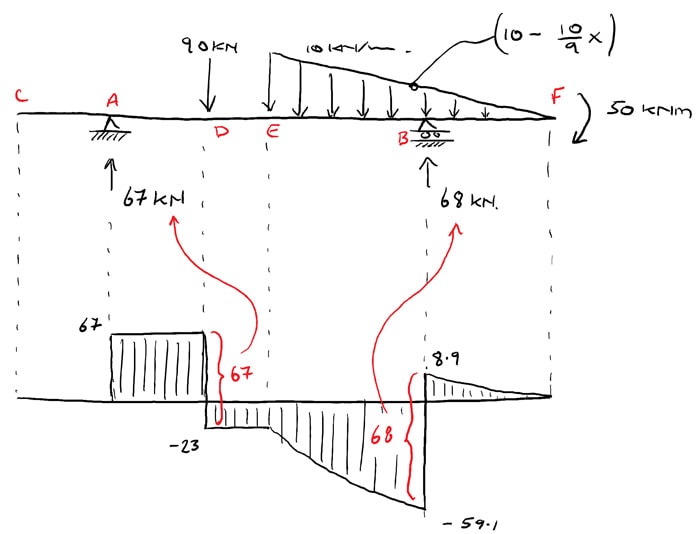
It's worth pausing for a moment to explain how the shear force to the left of B, ![]() was calculated. This is obtained by subtracting the total vertical load betwixt E and B from the shear force of
was calculated. This is obtained by subtracting the total vertical load betwixt E and B from the shear force of ![]() at E.
at E.
(24) ![]()
(25) ![]()
5.four Drawing the angle moment diagram
Once we've completed the shear force diagram, the angle moment diagram becomes much easier to make up one's mind. This is because we tin brand utilize of the following relationship between the shear strength ![]() and the slope of the bending moment diagram,
and the slope of the bending moment diagram,
(26) ![]()
Similarly to equation (23), this expressions allows the states to infer a qualitative shape for the bending moment diagram, based on the shear force diagram we've already calculated.
Consider the shear force betwixt A and D for instance; information technology's constant, which ways the gradient of the bending moment diagram is also constant (an inclined straight line). Betwixt D and E, the shear force is still constant but has changed sign. This tells united states the slope of the angle moment diagram has also changed sign, i.e. the angle moment diagram has a local peak at D.
The fact that the shear force is a polynomial (curve) between Eastward and F besides tells us the bending moment'south slope is continuously changing, i.e. it's also a bend. Merely the fact that the shear force changes sign at B, means the bending moment diagram has a peak at that point.
Finally, the externally practical moment at F tells us that the angle moment diagram at this location has a value of ![]() . We can combine all this information together to sketch out a qualitative bending moment diagram, based purely on the information encoded in the shear forcefulness diagram.
. We can combine all this information together to sketch out a qualitative bending moment diagram, based purely on the information encoded in the shear forcefulness diagram.
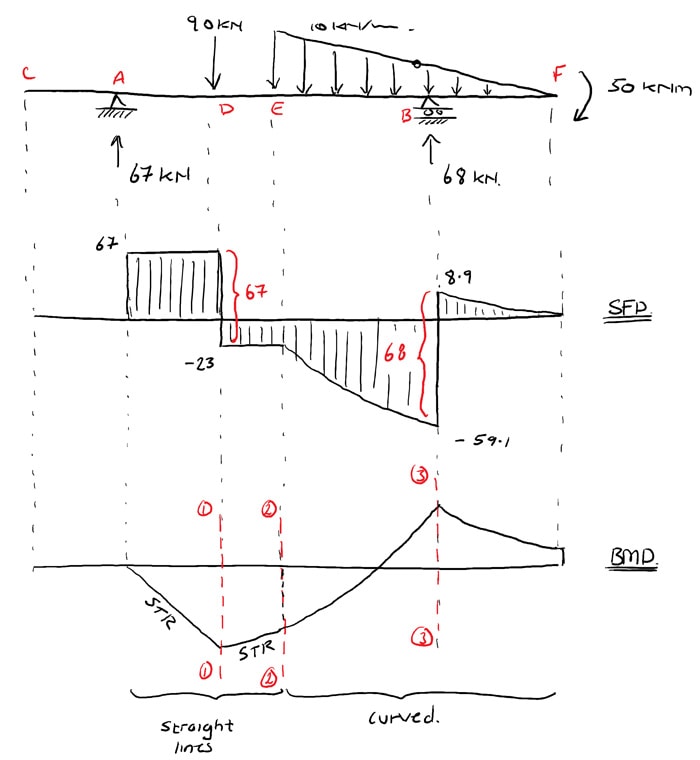
Now we simply have to cut the structure at detached locations (indicated with ruddy dashed lines above) to establish the diverse primal values required to quantitatively define the bending moment diagram. In this case three cuts are sufficient:
- at D to determine the local peak – Cut i-one
- at E to determine the value on the boundary between the straight and curved sections of the bending moment diagram – Cut ii-2
- at B to determine the local peak – Cut 3-three
Cut ane-1
As we've seen higher up, to determine the internal angle moment at D, ![]() , nosotros cut the construction to reveal the internal bending moment at this signal. Then past considering moment equilibrium of the sub-structure we can solve for the value of
, nosotros cut the construction to reveal the internal bending moment at this signal. Then past considering moment equilibrium of the sub-structure we can solve for the value of ![]() .
.
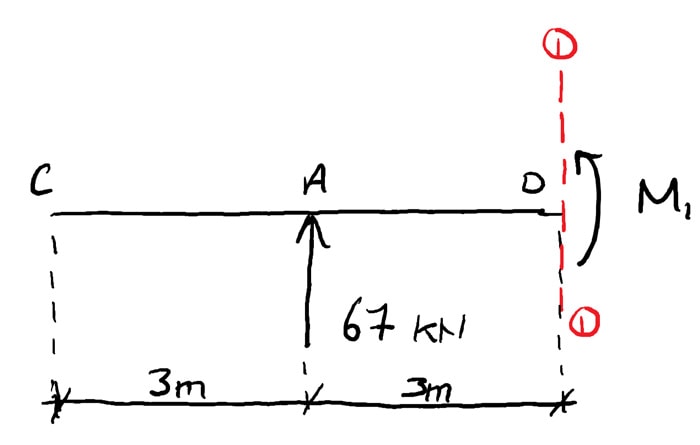
Taking the sum of the moments about the cut,
(27) ![]()
(28) ![]()
(29) ![]()
Cut ii-two
Repeating this process for cutting 2-ii,
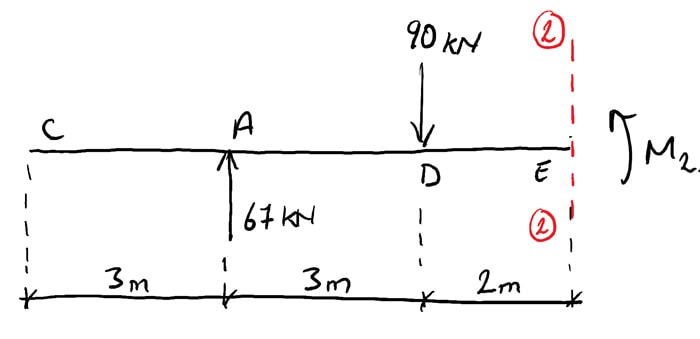
(30) ![]()
(31) ![]()
(32) ![]()
Cutting three-3
And finally for cutting iii-3, this time considering equilibrium of the sub-structure to the right-manus side of the cut
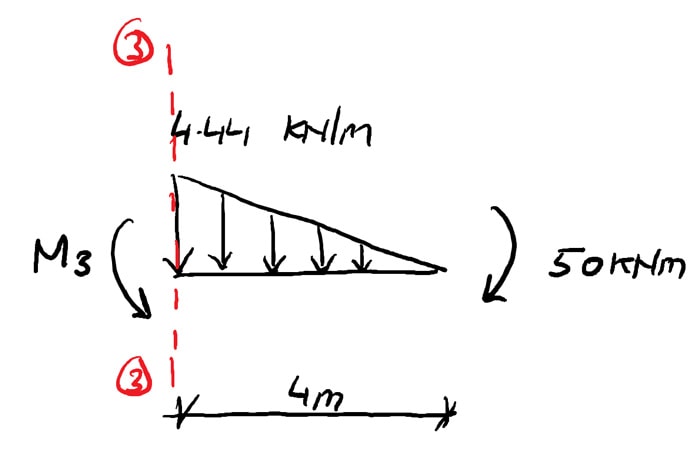
(33) ![]()
(34) ![]()
(35) ![]()
Nosotros can now sketch the complete quantitative bending moment diagram for the structure. In fact at this point we tin can summarise the output of our complete structural analysis.
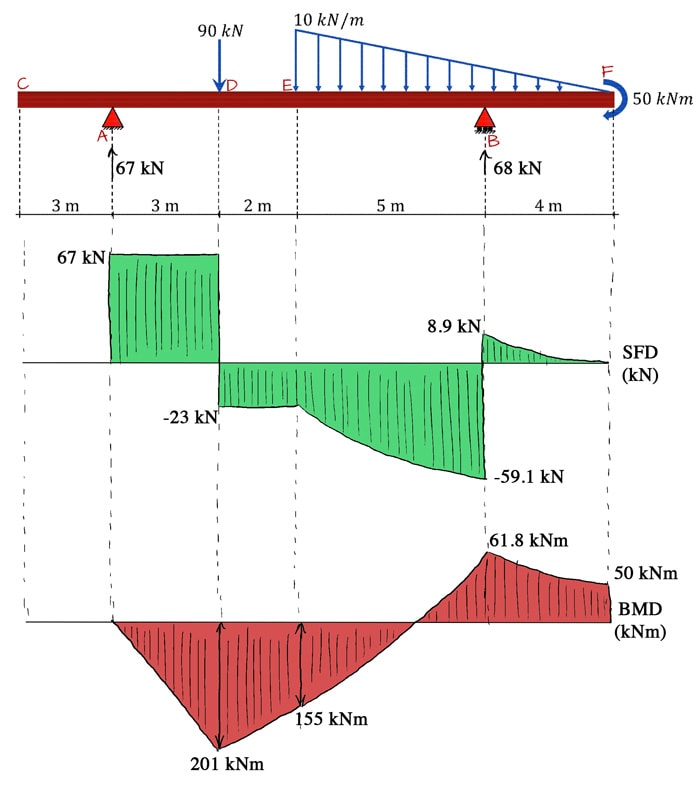
After working through this example, you might exist interesting in this postal service, where we work through edifice a shear force and bending moment reckoner using Python. We actually build our figurer around this case question – and so definitely worth a read when you finish up with this postal service.
6.0 Relating Loading, Shear Strength and Bending Moment
In the previous example, nosotros made use of two very helpful differential relationships that related loading with shear force and shear force with bending moment. However we didn't properly introduce them. Now that nosotros accept a good idea of the general workflow for generating shear and moment diagrams, we can dig a bit deeper into these differential relationships. Understanding these, is the key to being able to build shear force and bending moment diagrams apace and reliably.
Fully understanding the relationships nosotros derive next will allow y'all to more than 'intuitively extract' qualitative shear and moment diagrams 'past eye', with cuts used to confirm numerical values at salient points. We're going to explore 3 cases:
- Instance 1: Uniformly distributed loading
- Case 2: Point force loading
- Case 3: Indicate moment loading
In each case, our objective is to determine the relationship between the practical loading and the shear force and bending moment it induces.
vi.1 Instance 1: Uniformly distributed loading
Consider a short segment of length ![]() cut from a beam and subject field to a uniformly distributed load with intensity
cut from a beam and subject field to a uniformly distributed load with intensity ![]() kN/m. As nosotros saw above, these cuts accept revealed the internal moment and shear on either side of the segment. Annotation the infinitesimal increment in moment (
kN/m. As nosotros saw above, these cuts accept revealed the internal moment and shear on either side of the segment. Annotation the infinitesimal increment in moment (![]() ) and shear (
) and shear (![]() ) on the right side of the cut.
) on the right side of the cut.

Shear Force
We can outset by because vertical force equilibrium for the segment. Since it must be in a state of static equilibrium, the sum of the vertical forces must equal nix.
![]()
![]()
(36) ![]()
In other words, the slope of the shear force diagram ![]() at a point is equal to the negative of the load intensity at that betoken. We can demonstrate this with a uncomplicated example. Consider the beam below subject to a distributed load with linearly increasing intensity. By making a cut at a distance
at a point is equal to the negative of the load intensity at that betoken. We can demonstrate this with a uncomplicated example. Consider the beam below subject to a distributed load with linearly increasing intensity. By making a cut at a distance ![]() from the left support with reveal the internal shear forcefulness
from the left support with reveal the internal shear forcefulness ![]() .
.

If the load intensity increases linearly from nix to ![]() , then at the cut the load intensity is
, then at the cut the load intensity is ![]() . We can at present evaluate vertical force equilibrium for the sub-structure,
. We can at present evaluate vertical force equilibrium for the sub-structure,
![]()
![]()
We can now differentiate the expression for ![]() yielding,
yielding,
![]()
So we can come across that the differential of the shear force is equal to the negative of the load intensity. It'southward also worth noting the shape of the SFD, pictured below. At the left hand back up when the load intensity is zippo, the SFD has a value of ![]() (the value of the left reaction) just information technology is horizontal, i.due east. has a slope of zip. As the load intensity increases as we movement from left to right, the SFD gets steeper. i.east. the slope increases.
(the value of the left reaction) just information technology is horizontal, i.due east. has a slope of zip. As the load intensity increases as we movement from left to right, the SFD gets steeper. i.east. the slope increases.

Another implication of this differential relationship betwixt shear force and load intensity can be seen if we integrate both sides of the equation,
![]()
![]()
(37) 
We can see this represented graphically in the paradigm below.

Bending Moment
Having established the key relationship for shear, now nosotros tin can plow our attention to bending moments. Referring dorsum to our axle segment of length ![]() and because moment equilibrium of the segment by taking moments nearly the left manus side of the segment,
and because moment equilibrium of the segment by taking moments nearly the left manus side of the segment,
![]()
![]()
(38) ![]()
So, the slope of the BMD at a point equals the shear force at that point. Combined with the previous differential equation we derived, this is a very helpful equation. Whenever we have a axle subject field to a distributed load, nosotros can use these equations to infer the shape of the SFD and BMD. Consider the SFD and BMD for our beam below.

We note that when the shear strength is zero, the slope of the BMD is also goose egg indicating a local maximum in the BMD. We also note the alter in sign of the slope of the BMD as the shear force goes from positive to negative. Remember that the shape of the SFD was itself deduced from the shape of the loading diagram. By making utilize of these relationships between loading, SFD and BMD, we can build up a qualitative picture of structural behaviour.
half dozen.2 Case 2: Point force loading
Now nosotros repeat the aforementioned process every bit above but this time our beam segment is subject to a signal load ![]() located at
located at ![]() . Notation that on the correct mitt side of the element, the internal shear force and bending moment have increased by a finite amount rather than an infinitesimal amount equally was the case previously.
. Notation that on the correct mitt side of the element, the internal shear force and bending moment have increased by a finite amount rather than an infinitesimal amount equally was the case previously.

Shear Strength
Evaluating the sum of the vertical forces yields,
![]()
![]()
(39) ![]()
From this we run into that a point load induces a step modify in the SFD. We've already seen this when we followed the loads across the construction to build the shear forcefulness diagram above. This equation is simply the mathematical representation of this. Consider for example the simple instance below of a axle subject to two point loads.

Nosotros can readily see the step changes in the shear force diagram being equal to the magnitude of the signal loads at that location.
Bending Moment
If we at present consider moment equilibrium of our segment,
![]()
![]()

![]()
The presence of infinitesimally pocket-size segment lengths on the right paw side of the equal sign ways that ![]() is infinitesimally pocket-sized. From this we conclude that the presence of a bespeak load does not alter the value of the bending moment diagram at a point.
is infinitesimally pocket-sized. From this we conclude that the presence of a bespeak load does not alter the value of the bending moment diagram at a point.
However, noting that the shear forcefulness changes from ![]() to
to ![]() , nosotros tin say, according to the expression,
, nosotros tin say, according to the expression,
(40) ![]()
that the slope of the bending moment diagram changes by an corporeality ![]() . Over again, we can see how this maps onto our uncomplicated example below. Annotation that at the point of application of
. Over again, we can see how this maps onto our uncomplicated example below. Annotation that at the point of application of ![]() , the slope of the angle moment diagram changes. Also, where the shear forcefulness is zero, the bending moment diagram is horizontal.
, the slope of the angle moment diagram changes. Also, where the shear forcefulness is zero, the bending moment diagram is horizontal.
Then we have added ii more equations into our toolbox for establishing qualitative structural behaviour.

half-dozen.3 Instance 3: Point moment loading
Finally we can repeat the analysis for the case of moment applied at a point.

Shear Force
Take the sum of the forces in the vertical direction,
![]()
![]()
![]()
So, the shear force diagram does not modify with the application of a moment.
Angle Moment
Taking the sum of the moments about the left hand side of the cutting,
![]()
![]()
![]()
This means that at the bespeak of application of a bending moment, there is a step alter in the bending moment diagram, equal to the magnitude of the moment applied.
The 6 boxed equations in this section in a higher place tin can exist used to infer a huge amount of information about the behaviour of a construction under load. Let's put this into do with some other worked instance.
7.0 Some other Example
Determine the shear force diagram and bending moment diagram for the following simply supported beam. Make sure to attempt this yourself earlier watching the solution videos.

7.1 Setup and shear force diagram
vii.2 Building the bending moment diagram
7.3 Confirming maximum moment with calculus
So there yous have it. We've linked together the internal normal and shear stresses with the bending moment and shear force diagrams. And nosotros've derived a toolbox full of helpful differential equations to help us quickly and intuitively build shear force and angle moment diagrams. At that place is quite a lot more we could say about shear and moment diagrams. But that'southward probably plenty for 1 post.
The best manner for yous to become better at evaluating shear force and bending moment diagrams is through practice. There really are no shortcuts I'thousand afraid. The expert news is, the more you lot practice, the quicker you get and the stronger your intuition for structural behaviour becomes. That's all for now, I hope you got some value from reading this post and I'll meet you in the next i.
Build your ain shear strength and bending moment solver
Understanding how to build shear force and bending moment diagrams the way nosotros've demonstrated above is an essential skill. However, the procedure is time consuming, particularly when you enter the iterative process of analysis and design. And that'due south before we even start talking about how to handle indeterminate structures! For these reasons, nosotros more often than not make utilize of structural analysis software to speed the procedure up. Simply this software is typically expensive and for the vast majority of cases, has way more than functionality than we need. So – why not but build yous own, for (about) gratuitous! In my course below, we use the Straight Stiffness Method to build our own 2D axle and frame assay programme using Python. You don't demand to be a programmer to take this grade. When you're finished it…you'll take your own DIY structural analysis programme.
Source: https://www.degreetutors.com/shear-and-moment-diagrams/
Posted by: montgomerycourer1950.blogspot.com


0 Response to "How To Draw A Shear Diagram"
Post a Comment